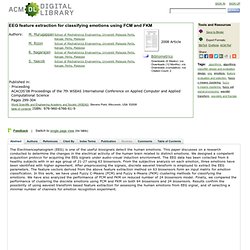

EEG feature extraction for classifying emotions using FCM and FKM. The Electroencephalogram (EEG) is one of the useful biosignals detect the human emotions.

This paper discusses on a research conducted to determine the changes in the electrical activity of the human brain related to distinct emotions. We designed a competent acquisition protocol for acquiring the EEG signals under audio-visual induction environment. The EEG data has been collected from 6 healthy subjects with in an age group of 21-27 using 63 biosensors. From the subjective analysis on each emotion, three emotions have been identified with higher agreement. After preprocessing the signals, discrete wavelet transform is employed to extract the EEG parameters. Software for Brain Computer Interfaces and Real Time Neurosciences. Capteurs neuronaux – Brain Computer Interfaces – Casque neuronal Emotiv EPOC (part1) Emotiv EPOC site web : www.emotiv.com .

En juin 2010, j’ai reçu une subvention de conception de la CWFB pour une performance/installation interactive utilisant un casque neuronal Emotiv EPOC. Cela faisait 5 ans que je suivais le projet de cet hardware, j’avais fait quelques tests rapides à plusieurs reprises, mais je n’avais encore jamais eu l’occasion de le tester réellement. J’ai reçu le casque il y a quelques mois, mais je dois bien avouer que je n’ai pas encore eu le temps de commencer le travail sur la performance.
J’ai cependant pris contact avec Axel Cleeremans du Consciousness, Cognition & Computation Group de l’Université Libre de Bruxelles et ai débuté une série de tests avec le NumediArt Institute for New Media Art Technology de l’Université de Mons. Même avec une bonne recherche Web, on se rend très vite compte qu’il y a assez peu de matière sur le sujet et que cela se résume souvent à des articles de type publicitaire, finalement assez flous.
Acquisition du matériel. NeuroServer software. Neuroserver is a project started by Rudi Cilibrasi to provide a standard EEG server that mediates between the raw EEG devices and all the various EEG applications that the user may wish to run to analyse the incoming EEG data.

Data is transmitted using TCP/IP, which means that the EEG data can just as easily pass over a network (or even the internet) as stay on the same machine. Standard EDF is used for header information and for file storage. The server is designed to run on Windows and Linux. Currently (Jul-2004), the server runs and handles data from the modularEEG device (P2/P3 firmware), and there is application support for it in BioEra, BrainBay and EEGMIR. More work is required in stress-testing and bug-fixing and adding more features. IBVA UK - applications of brainwave biofeedback. Ready to run on any version of Mac OS X is the beautiful IBVA version 5 software.

Experience the immersive feedback from your EEG when you explore the beauty of the IBVA software: Data sampling from 0-960 Hz per channel for very high frequency EEG, 1920 samples per second transmitted by Bluetooth (class 2.0 upto 2.1 M/bits per second). IBVA displays brainwaves in realtime rendered in 3D colour and recorded to your hard drive for up to 8 hours. IBVA has user defined display palettes and multiple windows, including Raw-graph, Bar-Graph and the classic animated left and right brain WaterFall. IBVA has user configurable Brainwave switches and mixers to control MIDI, Max, QuickTime, Quartz composer and internet interaction. You can use video with iSight Mac built-in camera integrated into IBVA4: Live iSight video window for simultaneous synched recording with EEG NEW !
This also acts as a remote control for Quartz composer animation with Quartz Composer iPhone plugin for Mac. NEW !